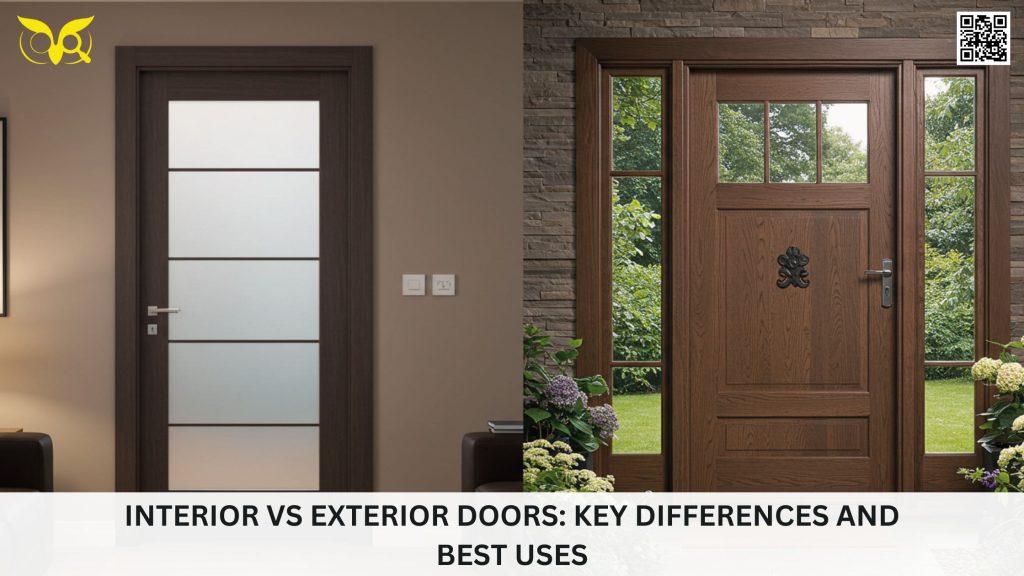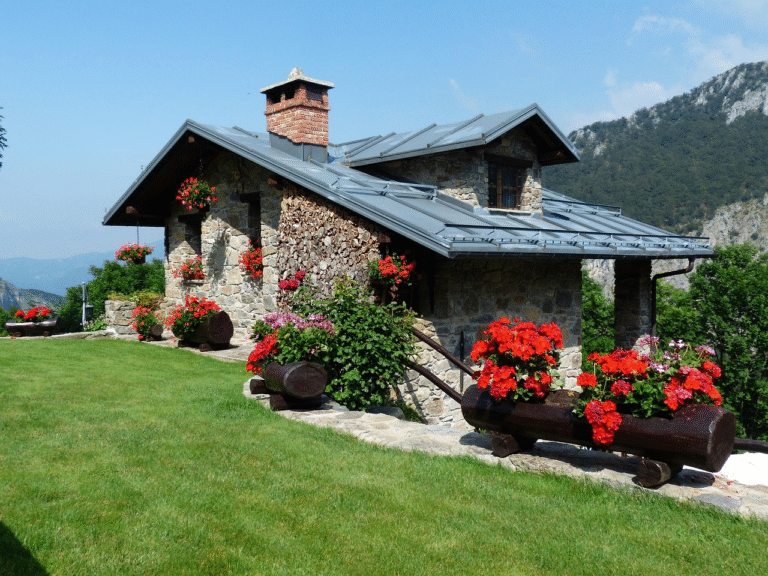Doors are more than just entry and exit points; they play a vital role in a home’s security, energy efficiency, and overall design. Whether you’re building a new property, renovating, or simply upgrading, choosing the right type of door can make a major impact on your space. But not all doors are built the same. Interior and exterior doors serve different purposes, use different materials, and are installed in different ways.

Understanding the distinctions between the two helps ensure that you’re not only choosing the right door for each space but also investing in functionality, safety, and style. Below, we break down the main differences and guide you on where and how each type is best used.
1. Purpose and Placement
Interior Doors: Dividing Space Within
Interior doors are designed to separate spaces inside the home. They provide privacy, reduce sound, and help define rooms, like bedrooms, bathrooms, closets, and offices. Their purpose is more functional and aesthetic rather than protective. Since they don’t face outdoor weather or provide entry to the home, they don’t need to offer insulation or security in the same way exterior doors do.
Exterior Doors: Protecting and Securing the Home
Exterior doors are your first line of defense. They must handle the elements, rain, sun, wind, and protect your home from intruders. You’ll find them at the front entrance, back patio, garage access, or any other place that connects your interior to the outdoors. They also contribute significantly to curb appeal and energy efficiency, especially in climates with extreme weather.
2. Material Differences
Interior Door Materials
Because interior doors don’t need to withstand harsh conditions, they can be made from lighter and less expensive materials. Common options include:
- Hollow Core: Made of plywood or molded composite with a cardboard honeycomb interior. These are affordable and lightweight but offer minimal sound insulation.
- Solid Core: Still covered in veneer or MDF but filled with a dense core. These offer better sound dampening and a sturdier feel.
- Solid Wood: High-quality option for rooms where aesthetics matter, like offices or master bedrooms. They’re heavier and more expensive but look and feel premium.
Exterior Door Materials
Exterior doors need to be durable, insulated, and weather-resistant. They are usually heavier and thicker. Popular materials include:
- Steel: Durable, low maintenance, and secure. Steel doors are often filled with insulating foam to improve energy efficiency.
- Fiberglass: Highly weather-resistant and versatile in design. These can mimic wood grain and are less prone to warping.
- Wood: Beautiful and traditional, but requires regular maintenance to resist warping or moisture damage. Great for style but not always ideal for high-exposure areas.
- Aluminum or Glass: Common in modern homes, especially in back patios or entrances that prioritize natural light.
3. Design and Aesthetic Considerations
Interior Doors: Consistency and Flow
For interior spaces, design is mostly about cohesion. Homeowners often choose doors that match the overall interior style, whether that’s minimalist, traditional, or rustic. Panel doors, flush doors, and barn-style sliding doors are popular choices. The aim is to keep things visually consistent from room to room.
Paint and finish options also play a role. Some prefer to have doors blend with the wall color to create a seamless look, while others use bold hues to create visual contrast.
Exterior Doors: Statement Pieces
Exterior doors are more likely to be design focal points. They’re one of the first things guests notice, and they set the tone for what’s inside. Front doors especially often feature glass panels, decorative inlays, or bold colors. But beyond looks, they must also meet energy codes and security standards. That’s why many homeowners look for the sweet spot between beauty and performance.
Back entrances, particularly those leading to patios or gardens, tend to incorporate more glass to bring the outdoors in. Large Sliding Doors are a growing trend here; they maximize natural light and create a smooth indoor-outdoor transition, ideal for entertaining and open-plan layouts.
4. Durability and Maintenance
Interior Doors
Interior doors have a relatively easy life. They aren’t exposed to moisture, UV rays, or temperature changes. That means they require less maintenance over time. Basic cleaning and the occasional touch-up for scratches or paint chips are usually enough. However, doors in high-traffic areas like kids’ bedrooms or laundry rooms can still get banged up and may need periodic tightening or hardware updates.
Exterior Doors
Exterior doors must endure a lot more. Sun, rain, wind, and fluctuating temperatures can all take a toll, especially in climates with heavy weather. Wood can swell, metal can rust, and seals can wear down. Regular maintenance is key—this might include:
- Repainting or re-staining every few years
- Checking weather stripping and thresholds
- Lubricating locks and hinges
- Inspecting for cracks or warping
Choosing low-maintenance materials like fiberglass or treated steel can reduce long-term upkeep while still offering high performance.
5. Insulation and Energy Efficiency
Interior Doors
Most interior doors don’t require insulation since they don’t separate indoor from outdoor air. However, sound insulation can be a concern, especially in bedrooms, offices, or shared spaces. Solid core doors are the go-to here—they provide much better sound control than hollow core models.
Exterior Doors
Insulation is crucial for exterior doors. Heat loss through poorly sealed or thin doors can increase energy bills and decrease comfort. Most modern exterior doors are rated by energy efficiency standards and include:
- Foam insulation cores
- Thermal breaks (especially in metal doors)
- Double or triple-pane glass in doors with windows
- High-quality weather stripping
Glass doors, like French doors or sliding doors, should use Low-E glass and be rated for insulation and UV resistance to prevent heat transfer and fading of interior finishes.
6. Security Features
Interior Doors
Security isn’t a major concern for interior doors. Most have simple latch locks or even no locks at all. Bedroom and bathroom doors may feature privacy locks, but these are easily bypassed in emergencies. The focus is more on convenience and accessibility than on protection.
Exterior Doors
Security is a top priority for exterior doors. Standard features include:
- Deadbolts
- Reinforced strike plates
- Multi-point locking systems
- Smart lock integrations
- Solid or metal cores to resist forced entry
Additionally, many modern front doors integrate with home automation systems for remote locking, video doorbells, and access tracking.
7. Cost Differences
Interior Doors
Interior doors are generally more affordable. Hollow core models can start as low as \$30 to \$50 per door, while solid wood interior doors may range from \$200 to \$500, depending on wood type and finish. Installation costs are also lower because they don’t need sealing, weatherproofing, or heavy framing.
Exterior Doors
Exterior doors are an investment. Steel and fiberglass options start around \$300 to \$500 for basic models, but premium wood or designer doors can run into the thousands. Add installation costs (often \$500–\$1000), and the price reflects the additional complexity, such as thresholds, security hardware, insulation, and finishing.
However, the right exterior door can boost curb appeal and add significant value to a property, especially if it’s a front entry door with visual impact.
8. Installation and Framing
Interior Doors
Installing an interior door is a relatively straightforward process. Since interior walls are not load-bearing in the same way exterior walls are, the framing requirements are simpler. Pre-hung doors make installation even easier for DIYers or contractors.
Exterior Doors
Exterior door installation is more complex. You need to account for:
- Proper sealing against the weather
- Threshold and sill installation
- Reinforced framing for security
- Correct swing direction (inward vs outward)
- Energy code compliance
Improper installation can lead to drafts, water damage, or even structural problems, so this is typically a job best left to professionals.
9. Customization Options
While both interior and exterior doors can be customized, exterior doors usually offer more variety in terms of features and styles. Homeowners can choose from:
- Decorative glass inserts
- Integrated sidelights and transoms
- Smart locks and built-in video systems
- Custom heights and widths
- Impact-resistant or fire-rated models
Interior doors, on the other hand, tend to follow standard sizes and simpler design options. However, interior design trends have brought more attention to doors, with people opting for bold colors, glass inserts, or even unique options like pocket doors and barn sliders.
Understanding the distinction between interior and exterior doors isn’t just about knowing where each type goes. It’s about making informed choices that enhance comfort, performance, and style. Whether you’re designing for privacy inside or durability outside, the right door can dramatically improve how your space looks and feels.
Visit Baddiehub Homepage for more.






